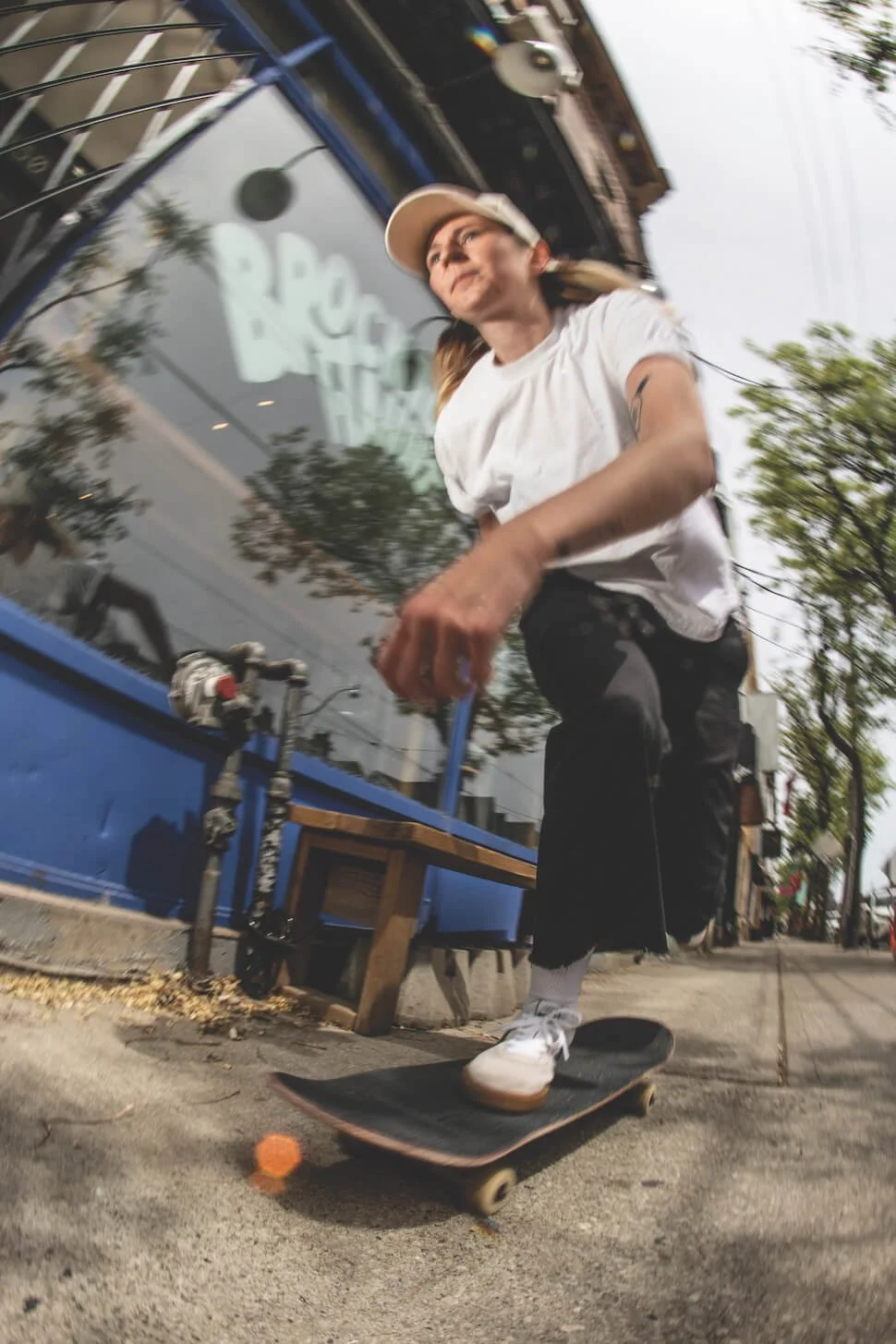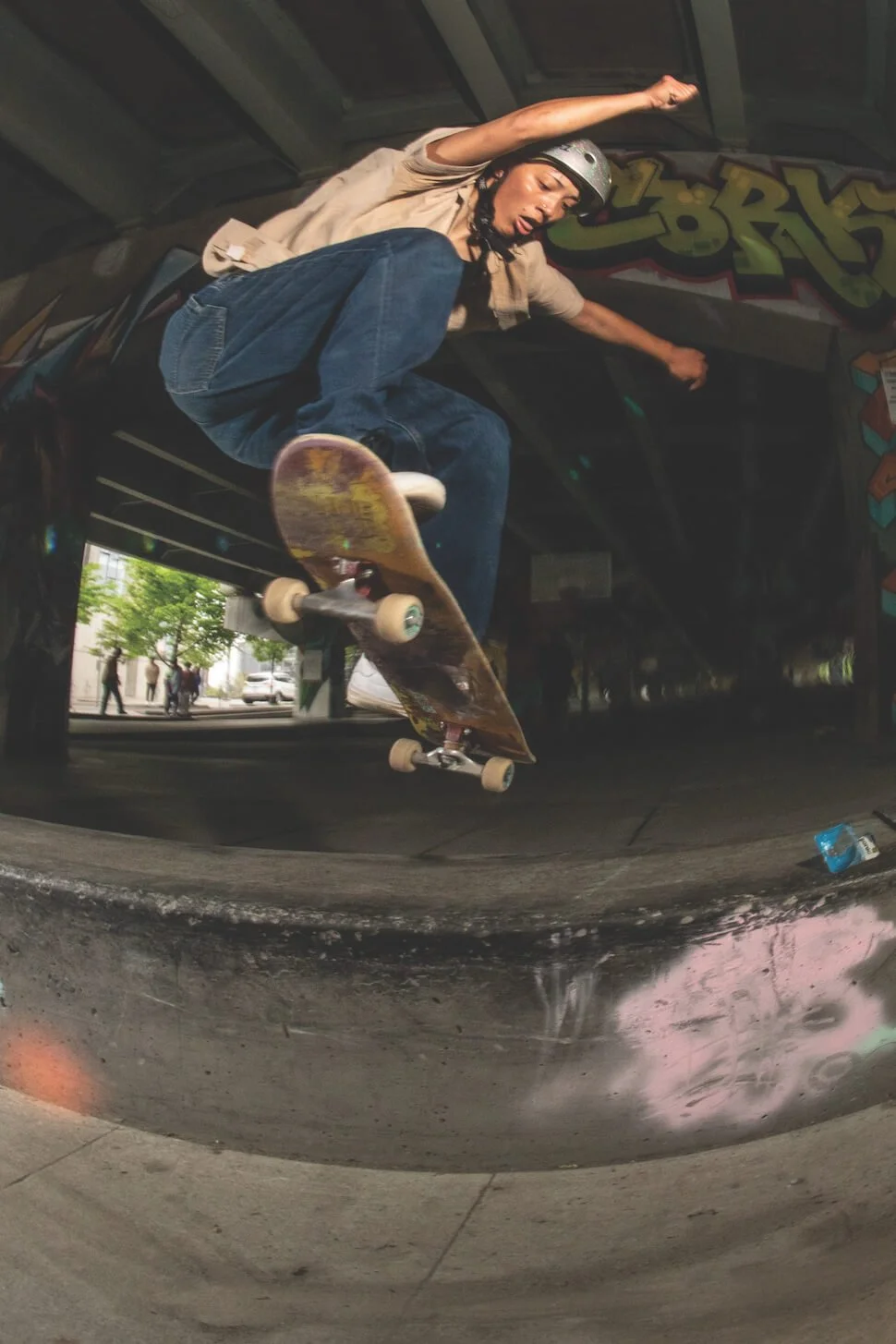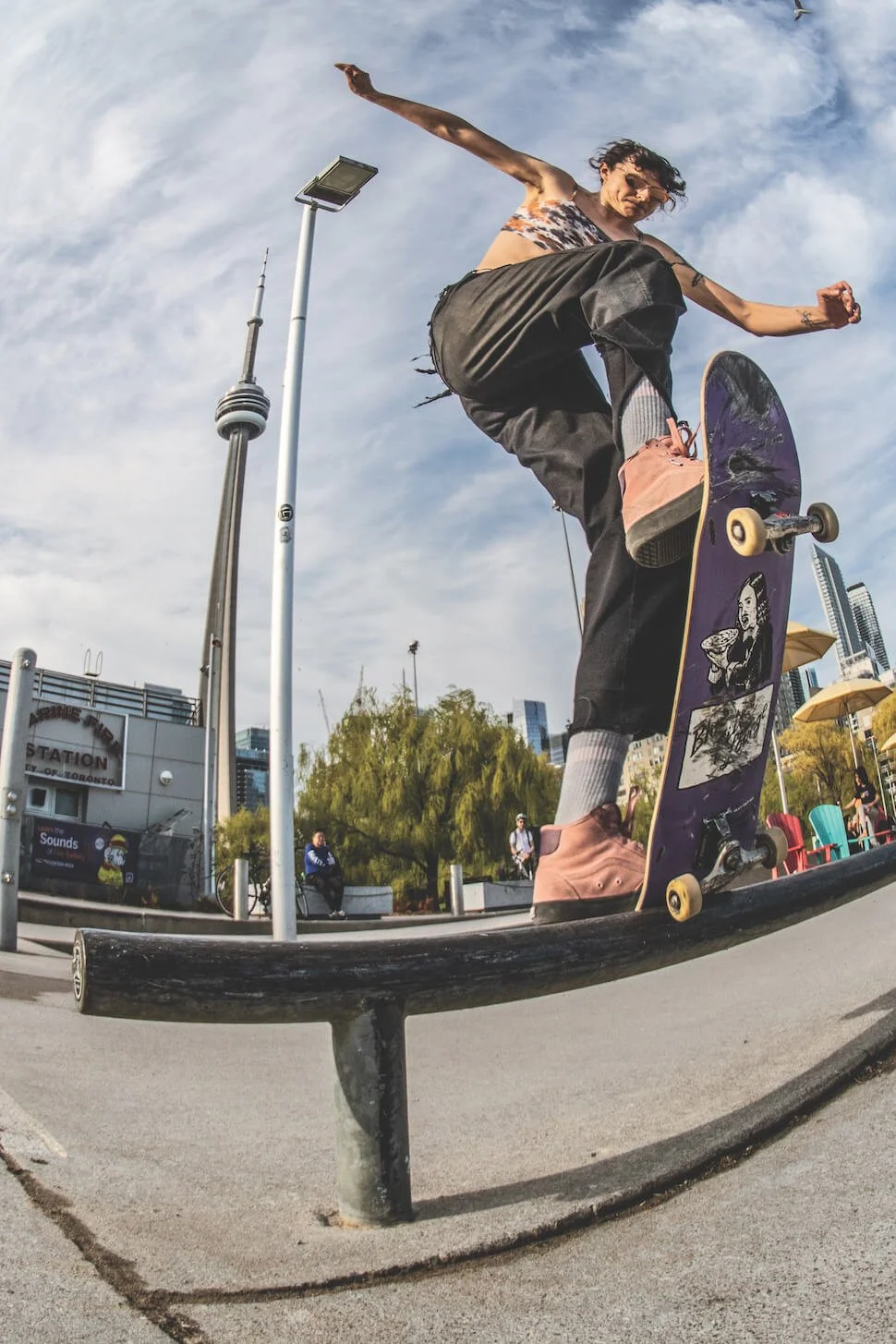IT'S OKAY TO TAKE UP SPACE AT THE SKATE PARK
FROM JUNE 2022 ISSUE OF WEST END PHOENIX
Once a stronghold for straight dudes, the skateboarding scene is finally opening up to queer riders. Four skaters talk about how they made inroads and found a loving community along the way.
There's a shop on the north side of College Street, a blue building on a busy stretch just west of Dufferin, that sits across the road from an endless line of duplexes. In chipped white paint, its unassuming sign spells out its mission statement: “coffee + skateboards.”
This is Brockton Haunt.
It’s a coffee shop that for a time had the same single purpose as so many others in the city: the delivery of caffeination. But that changed early in the pandemic.
Owner Julie Kell had worked in a skate shop when she was a teen and knew how intimidating those places could be. When business slowed during the lockdown, she found herself reflecting on the baggage that came with most skate spaces, “even if it’s the friendliest place.” She hashed it out with her girlfriend. “We were talking about how many queers are starting to skateboard, and kids, or their moms – just so many different types of people,” Kell says. Her girlfriend said, “Maybe you should start a skate shop,” Kell recalls. “And I thought, ‘Holy shit, maybe I should.’”
Skateboarding has always been seen as a sport that’s more egalitarian than the others: At least outside of the Olympics, it isn’t walled off by a gender binary. It is by nature a sport of freedom, silicone wheels on endless pavement that can take you anywhere. It was supposed to be for anyone. Yet that prevailing image was dominated for a long time by a singular archetype: a straight guy, a cis dude.
Brockton Haunt owner Julie Kell has turned her coffee shop into a skateboarding hub.
Kell was lured into the fold by the most unlikely of influencers. “I saw Bart skateboarding on The Simpsons,” she says with a laugh, “and I told my dad, ‘I have to get a skateboard.’”
Her dad didn’t know how to skate but was able to figure it out well enough to get her started on an inexpensive board from Walmart. From there Kell started skating with her older sister’s boyfriend, five years her senior but patient and willing to show her the ropes.
Kell grew up in Saskatchewan, with a large and vibrant skate scene, first with kids in her neighbourhood who were similarly obsessed. They were, as Kell tells it, “obviously mostly dudes.” When she was 19, she worked at a local skate shop, but as she got older, she found herself surrounded by fewer people she could ride with. When she moved to Toronto in 2011, she had a skate deck but felt disinclined to spend much time on it on her own.
That part of her story isn’t uncommon.
Chantal Garcia is a local skater, photographer and organizer. She’s the driving force behind Queer Skate Toronto, a local meetup for queer and trans skaters. Garcia started skateboarding at age eight, when she found a board at a garage sale in North Bay, where she grew up. She too spent her youth skateboarding, on her own and with boys in her neighbourhood, but eventually skating fell away from her. “When you get older, you stop hanging out with the neighbourhood boys,” Garcia says. “I stopped and didn’t pick it back up again until I was 25.”
Skater and photographer Chantal Garcia, who started a Toronto meetup for queer and trans skaters, calls skating “a really good bonding agent.”
In high school, Garcia recalls trying to adapt to the conventional trappings of the North American teen in the early aughts. “You get into high school and you’re trying to find yourself. I really did my best to adapt to high school standards. I went to American Eagle and bought tight shirts and was a preppy for Grade 9 and just changed myself and went through this wandering period,” Garcia says. “Skateboarding didn’t really fit in.”
Moving to Toronto in her early 20s, though, Garcia felt a disconnect. “Everything was going really well, but a spark was missing,” she recalls. “I always loved skateboarding, so I just decided, I’m old enough to just do this on my own. I don’t need to have friends to do it.”
Garcia bought a new board and just started skating on her own in parking lots, which she affectionately recalls as being “awkward and weird sometimes, but I did it anyway.” Searching online for groups of women who were also skating led her to Babes Brigade, a group of women skaters in Toronto. “That’s where I ended up meeting a lot of my friends. Offering a platform to meet other people was kind of key.
“The first meetup was awkward; we all went to this indoor skate park in North Toronto in a warehouse behind a trucking company. It was sketchy and weird, but we showed up and we were all intimidated by each other,” Garcia remembers. “But the great thing about skateboarding is you don’t have to have anything in common with someone; it could just be skateboarding, and you can get along just fine for the day. It’s a really good bonding agent.”
That first meeting sealed it for her. Garcia was back every week as often as she was able, buoyed by the vibrancy of support from the other women skating with her. Trips to skate parks, outside the purview of Babes Brigades meetups, were another story. “It was always a planned outing,” Garcia says. “It can be an intimidating place to show up alone.”
Skater Yumi Lee remembers the first time she met a non-binary person who skated. “I had never seen someone who was a skater that I could relate to.” It made her think, “I’m gonna do this.”
Yumi Lee is a skater from York who is the co-founder and a lead instructor at York Skateboarding Academy, a skateboarding school in the GTA that teaches the fundamentals of the sport to any and all interested parties in an inclusive environment. Like Garcia and Kell, she wanted to skate from a young age. “I would see people skateboarding and I would think, Oh, that’s really sick,” Lee says. “But as a woman – and a woman of colour – I just always saw heteros, white men, skateboarding and I thought, Oh this isn’t really for me.”
In the middle of her teen years, Lee went through “a queer self-discovery phase” and went to get her hair cut short. The hairdresser, in a serendipitous turn of events, was a vehicle for change. “This really cool non-binary person who I talked to while they were cutting my hair was like, ‘Oh, I play softball, I skateboard, I do this and this,’ and I was so excited,” Lee recalls. “I was like, ‘You skateboard?’ I had never seen someone that was a skateboarder who I could relate to.”
That was the final push she needed. “I’m gonna do this,” Lee thought, recalling her newfound determination. She bought a board at Zumiez from a local skater who showed her the basics: how to get on the board and what she needed for gear. The first day she just skated in front of her house, but by day two she was heading to a skate park nearby, where she found a group of girls who were also getting into skating.
Lee is also a co-founder and an instructor at York Skateboarding Academy, which teaches skills in an inclusive environment.
Still, she spent most of that first year boarding alone; in spare moments, she watched skateboarding videos on YouTube and eventually found other skaters on Instagram to connect with.
One of them landed a quote that resonated deeply with Lee. “When she talked about girls skateboarding she said, ‘It’s okay for girls to take up space at the skate park.’ I find that people – queer people or people of colour – are always scared to get in people’s way, and at the skate park I found that you kind of have to be okay with getting in people’s way.”
In her years on a board, Lee has grown in her skill as a skater, which has led to new issues. “I get mistaken for a dude, specifically at the skate park, almost every day,” she says. “People have told me, ‘It’s not even how you dress or your hair or whatever. It’s because you’re good.’”
Moments like that create power vacuums, weird instances that are hard to wrap one’s head around.
“Because I’m gender queer I think, what does this mean about how people are perceiving me?” Lee says, “because I don’t know if what they’re saying about me is something I want or something that I’m trying to suppress.”
Annie Jane Marie, who’s been riding since she was young, says, “Skateboarders always used to talk about how open skateboarding was while at the same time not actually being that open. But it definitely has the potential to be, and it’s getting better and better.”
Annie Jane Marie is a skater in Toronto who’s been riding since she was young. “My sister bought me a couple of skate videos for my birthday one year, and that got me really into it,” she says. For the first few decades, the scene was very homogeneous. “It was mostly straight boys,” she recalls.
But the cultural landscape of all things is always in flux, and skating is no different. “The skate scene has changed so much in the last five years. The demographic has shifted so drastically,” Marie says. It helps too that there are groups like Queer Skate Toronto organizing weekly meetups, and creating opportunities to bond with fellow trans skaters. It was a chance encounter at a local skate park that provided a glimpse into the possibility of being trans and a skater for Marie. “I remember going to a park early last year, and these younger guys that I would see around the skate park were there, and this trans woman showed up and she was friends with them,” she recalls, “and I was like, Oh yeah, maybe it’s just not a thing. Maybe people don’t care anymore.”
“Skateboarders always used to talk about how open skateboarding was while at the same time not actually being that open. But it definitely has the potential to be, and it’s getting better and better,” Jane Marie says.
Skate shops and brands like Vans and Converse are promoting Pride events and making merchandise aimed at queer demographics, placing newfound attention on queer skaters. Rainbow capitalism never shies away from finding new markets, but it’s undeniable that there is a growing interest in opening the door to skate scenes, and it’s the brave few keeping a foot firmly wedged in the door that allows entry for all.






